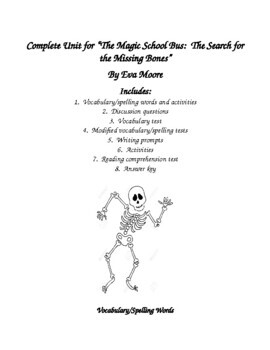"The Magic School Bus: The Search for the Missing Bones" by Eva Moore Unit
- Word Document File
Also included in
- Ms. Frizzle loves science. So to help her students gain knowledge of whatever topic in science her class is covering, she takes them on lots of magical field trips via the Magic School Bus. These books are a great way to combine language arts and science together. This bundle includes all twentyPrice $40.00Original Price $60.00Save $20.00
Description
This is the second book in the Magic School Bus chapter book series. It's Halloween time and Ms. Frizzle has brought in skeleton costumes for her class. The only problem is that the costumes are missing bones. So she takes her class to the costume company, and while there, her class learns about the human skeleton. This book is a perfect way to combine language arts with science!
This unit includes the following? spelling/vocabulary words and activities, discussion questions, vocabulary test, modified vocabulary/spelling tests, writing prompts, activities, reading comprehension test, and answer key.
This unit would also be ideal for homeschool instruction, independent study, and/or differentiating reading instruction for either individuals or small groups.






